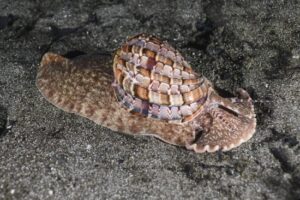In Greek mythology, Triton, son of Poseidon and god of the sea, is often depicted blowing a horn/shell that looks just like that of the Charonia snail, earning them their common name “Triton’s trumpet” or “Triton snail”. Triton snails are one of the world’s largest marine snails, with species reaching up to half a meter (20 inches) in length.
Unlike many other snails, tritons are not hermaphrodites. Their population is made up of individuals with separate sexes who undergo internal fertilization (meaning that the eggs are fertilized inside a female’s body). Once the eggs are fertilized, the female buries eggs in the sand at the bottom of the sea. These eggs develop into free-swimming larvae that become part of the plankton for the next few months before they fully grow into adult snails.
When we think about snails, we don’t usually picture them as ferocious predators that chase their prey, however, tritons are fierce predators that have an essential role in maintaining healthy coral reefs. They are one of few marine predators that can feed on the Crown of Thorns starfish, which specializes in feeding upon the flesh of live corals. Crown of Thorns starfish have a keen sense of smell and can spot tritons from quite a distance. Once the starfish senses danger, it starts to run away from the snail. This starts a wild underwater chase that surprisingly always ends with the triton’s victory. These snails can easily outrun the starfish and immobilize them with their venomous saliva.
Giant tritons are recognized by the Australian government as one of the key species for improving damage to the Great Barrier Reef and have been under strict protection since the 1960s. Unfortunately, due to the beauty and impressive size of their calcium carbonate shells, tritons are often harvested from coral reefs, and their shells are sold to collectors worldwide.
Written by Lena Ilic, B.Sc., Marine Biologist
Photos by Janez Kranjc and Ivana OK
The post The Triton Snail appeared first on Mares – Scuba Diving Blog.
Read MoreDiving, Adriatic Sea, biodiversity, marine life, snail, starfish, TritonMares – Scuba Diving Blog


